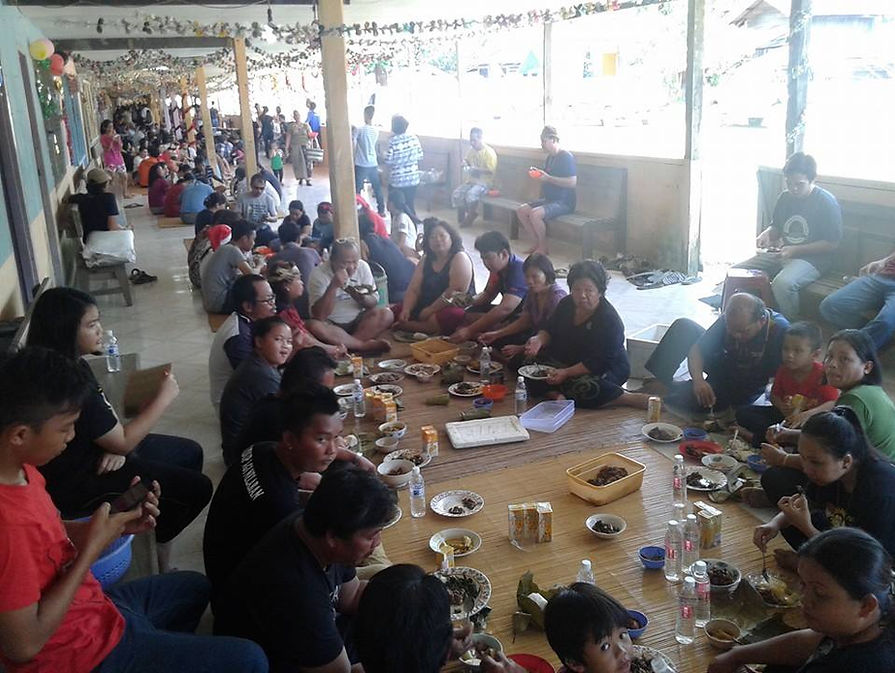Kayan Language Legacy Project
Acerca de
On this page you will find some cultural practices that one usually observed in the longhouse.
Te' lapan anih te' kuri-kuri hadui dahin adet tam Kayan awi jam tuk hadui-hadui keli'ah tam ha' uma aru.

Community and togetherness
The Kayan in Sarawak have a strong sense of community, partly due to their small population. Estimated at around 27,000, they live in longhouses located in the upper reaches of the Baram and Belaga rivers. In the past, this sense of togetherness was especially strong. They farmed, hunted, and lived as a close-knit community. Even today, many Kayan continue to live in longhouses. Although some have moved to the cities for work, they often return to the longhouse to celebrate Christmas and still consider it their original home.
A call for unity and togetherness is a recurring theme in the Kayan narrative of asen (origin or identity), and the concept of puhu ("we, the Kayan people") often appears in their conversations and oral traditions.
Among the Kayan, it is customary to hold a pahlung—a communal meal—during Christmas. This usually takes place after the morning Christmas service, with lunch shared at the headman’s awa (verandah). It is a special time to reconnect, as many people have been away from the longhouse. Christmas and pahlung are deeply associated with togetherness.
Daha' pahlung aleng anih. Nunih nah gaya' tam Kayan, pahlung tam tegu krimas. Uh uli sebayang jehima, bo tey nah itam pahlung te' awa aya'. Itam tey ngelu'an atih, tey pesuk daha' panak dahin bakeh tam aleng ney men ha'oh. Mijan tam pesuk lahuh pa, jaka anih nah itam pesuk.

Culture and Cultural practices
Anih Hinan Jakius bara marung nuno tuk na hung. Usi nah akui bara lim dahun na' tinih bi harap kelo kelenghi dahin sayu kenep.
This is Hinan Jakius (the mother of Jakius) explaining how to make the Kayan sun-hat. The transcript for this is not provided but I hope you enjoy listening.
Mei Sali dawa Hinan Jakius bara nuno' na buvo'
Mei Sali dawa Hinan Jakius bara marung nuno' na buvo'. Bih anih buvo' maring, usi anih buvo' wei awi kenan tam Kayan menuna'. This is a new way to make buvo' or fish trap using a kind of plastic string. In the past buvo' or fish trap were made from bamboo.
Mei Sali tey meju pukat
Mai Sali getting ready to go 'catch fish' - te' meju pukat.
This is a daily activity among Kayan men, especially the younger ones, who view metuk pukat (fish netting) not only as a way to provide food for their families but also as a leisure activity. In the past, meju pukat was a necessity, as they relied on the forest and rivers to source their food.
Anih nah hadui daha' lake' Kayan, bi lebih2 na' men dalo' nyam. Tey mukat nih avan daha' ilo ket en daha' kani (masik) men amin daha' bi daha' nyam kere' nih avan daha' tey ngelu'an lim kah lahuh. Menuna, nunih nah daha' ilo kuman daha', ket men tana dahin men unge'.
Today, most Kayan families own at least one small engine-powered boat, which they use to travel along the rivers for fishing or to reach their farms. This has greatly improved their mobility, as in the past, they had to paddle for hours to get to their farming areas.
Here, Mai (Uncle) Sali is hoping for a good catch in his net. The net was set in a small stream of the Apoh River, a distributary of the Tutoh River, along which the Long Panai longhouse is located. Unfortunately, there was no catch today—hopefully, tomorrow will be better.
Harap lan Mai Sali te' masik kelan na' danih dih. Ha' alem ungey uk halam Apoh ha' metuk pukat na' anih. Ungey Apoh nih anak ungey Tutoh kah anih, ungey te' uma telo Long Pane'
Asi asi nah, usi te' masik kelan pukat na'. Harap jima te' masik kelan na' ji'ek.

Uli uma pake' 4-wheel drive anih
The roads to Kayan longhouses in the Baram are generally still dirt roads. They were originally constructed by timber companies to access their oil palm plantations. Most of these roads pass through areas inhabited by Indigenous communities and are crucial for providing access to the nearby towns of Marudi and Miri.
Nunih nah gaya alan tam tei ha uma aru. Alan anih usi alan kenan pelitah. Alan camp anih kurin tam Kayan. Alan besa nunih nah aleng tam pake' avan tam te' ha pasen Maludi dahin Miri.